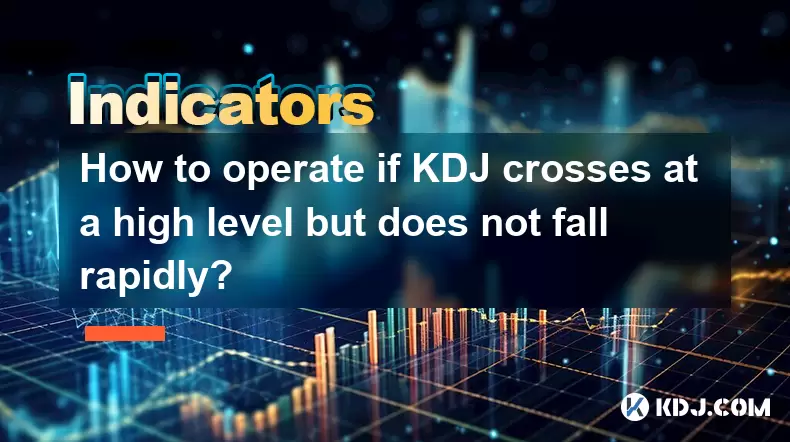-
 bitcoin
bitcoin $87959.907984 USD
1.34% -
 ethereum
ethereum $2920.497338 USD
3.04% -
 tether
tether $0.999775 USD
0.00% -
 xrp
xrp $2.237324 USD
8.12% -
 bnb
bnb $860.243768 USD
0.90% -
 solana
solana $138.089498 USD
5.43% -
 usd-coin
usd-coin $0.999807 USD
0.01% -
 tron
tron $0.272801 USD
-1.53% -
 dogecoin
dogecoin $0.150904 USD
2.96% -
 cardano
cardano $0.421635 USD
1.97% -
 hyperliquid
hyperliquid $32.152445 USD
2.23% -
 bitcoin-cash
bitcoin-cash $533.301069 USD
-1.94% -
 chainlink
chainlink $12.953417 USD
2.68% -
 unus-sed-leo
unus-sed-leo $9.535951 USD
0.73% -
 zcash
zcash $521.483386 USD
-2.87%
How to operate if KDJ crosses at a high level but does not fall rapidly?
When KDJ crosses at a high level but doesn't fall rapidly, it may signal strong bullish momentum rather than an immediate reversal, especially in trending crypto markets.
Jun 18, 2025 at 12:35 pm

Understanding KDJ Indicator Basics
The KDJ indicator, also known as the stochastic oscillator, is a momentum-based technical analysis tool widely used in cryptocurrency trading. It consists of three lines: K-line (fast stochastic), D-line (slow stochastic), and J-line (divergence). The primary function of this indicator is to identify overbought or oversold conditions and potential reversal points in price movements.
When the KDJ crosses at a high level, it typically indicates that the asset may be overbought. However, if the K value does not fall rapidly, it suggests that the uptrend might still have strength and that selling pressure hasn't yet taken control. This situation can be confusing for traders who expect an immediate reversal after a high-level crossover.
Recognizing High-Level KDJ Crossover Patterns
A high-level KDJ crossover generally occurs when both the K and D values are above 80. This threshold signifies overbought territory. In such scenarios, a bearish signal is usually expected. Yet, in some cases, especially during strong bullish trends in crypto markets, the K line remains elevated without dropping quickly, indicating persistent buying interest.
This phenomenon can occur due to several factors:
- Strong market sentiment pushing prices higher
- Institutional accumulation continuing despite short-term resistance
- Lack of significant sell orders causing delayed correction
It's crucial to understand that KDJ should not be used in isolation. Traders must combine it with other indicators like RSI, MACD, or volume patterns to confirm trend strength and possible reversals.
Interpreting Price Action Alongside KDJ Behavior
When the KDJ crosses at a high level but doesn’t fall rapidly, one should closely monitor the price action on the chart. If the price continues to rise or consolidates sideways, it may suggest that the bulls are still in control. Conversely, if the price forms bearish candlestick patterns while KDJ remains elevated, it could indicate an imminent pullback.
Key observations include:
- Higher highs in price with non-diverging KDJ levels
- Bearish engulfing candles appearing despite high KDJ readings
- Volume spikes indicating either continuation or exhaustion
Traders should watch for divergence between the KDJ and price movement. For example, if the price makes a new high but the KDJ fails to make a corresponding high, this could signal weakening momentum even if the K value doesn’t drop immediately.
Strategic Trading Approaches When KDJ Stalls at High Levels
In situations where the KDJ remains high without a rapid decline, traders can consider the following strategies:
- Wait for confirmation signals: Instead of reacting immediately, wait for candlestick patterns or other indicators to confirm a trend change.
- Use trailing stops: If already in a long position, adjust stop-loss levels upward to protect profits while allowing room for continued upside.
- Monitor support levels: Identify key support zones where price may find buying interest if a pullback begins.
- Observe time decay: Extended periods of high KDJ values may eventually lead to a correction, so timing entries based on consolidation breakouts can be effective.
Avoid making impulsive decisions solely based on KDJ readings. The crypto market is highly volatile, and false signals are common. Always cross-reference with other tools before taking action.
Practical Steps to Execute Trades During High-Level KDJ Conditions
If you're considering a trade when KDJ crosses at a high level but does not fall rapidly, follow these detailed steps:
- Step 1: Confirm trend direction using moving averages: Use the 20-period and 50-period EMA to determine whether the trend is bullish or bearish.
- Step 2: Check RSI alignment: Ensure RSI is not showing overbought divergence; ideally, RSI should remain above 50 to support a bullish bias.
- Step 3: Watch volume behavior: Look for increasing volume on up days and decreasing volume on down days to validate trend strength.
- Step 4: Set conditional orders: Place take-profit orders near previous resistance levels and set dynamic stop-loss orders below recent swing lows.
- Step 5: Monitor news flow: Be aware of upcoming events or announcements that could impact the cryptocurrency’s price dynamics.
By integrating these steps into your trading routine, you can better manage risk and improve decision-making accuracy in uncertain KDJ environments.
Frequently Asked Questions
Q: What does it mean if KDJ stays above 80 for multiple candlesticks?A: A prolonged stay above 80 indicates strong bullish momentum. While traditionally seen as overbought, in trending markets, it may reflect sustained demand rather than an imminent reversal.
Q: Can I use KDJ alone to make trading decisions in crypto?A: No, relying solely on KDJ increases the risk of false signals. It’s best used alongside complementary indicators like MACD, RSI, and volume analysis for more reliable results.
Q: How do I know when to exit a trade if KDJ doesn’t fall after crossing at a high level?A: Focus on price structure and support/resistance levels. If the price starts forming lower highs or closes below key supports, it may be a good time to reassess your position.
Q: Does KDJ perform differently on various timeframes in crypto trading?A: Yes, shorter timeframes like 15-minute or 1-hour charts tend to produce more frequent but less reliable KDJ signals. Higher timeframes like 4-hour or daily offer more robust readings but fewer trading opportunities.
Disclaimer:info@kdj.com
The information provided is not trading advice. kdj.com does not assume any responsibility for any investments made based on the information provided in this article. Cryptocurrencies are highly volatile and it is highly recommended that you invest with caution after thorough research!
If you believe that the content used on this website infringes your copyright, please contact us immediately (info@kdj.com) and we will delete it promptly.
- GeeFi Rockets Towards 100x Returns, While Ripple Makes Strategic Stablecoin Moves
- 2025-12-20 06:15:02
- Big City Crypto Buzz: Cross-Chain Bridges, Multi-Chain Horizons, and Presales Paving the Future
- 2025-12-19 21:45:01
- Ray Dalio's Portfolio Prescription: Why Bitcoin and Gold Are Essential in a Debt-Ridden World
- 2025-12-19 01:35:01
- Taiwan's Bitcoin Trove: Criminal Investigations Unearth a Surprising Global Ranking
- 2025-12-19 01:30:02
- Coinbase's Bold Leap: Stocks, Prediction Markets, and the Future of Trading
- 2025-12-19 01:35:01
- Kaito, Kickstarter, and the Post-TGE Crash: Navigating Crypto's Volatile Launch Landscape
- 2025-12-19 01:15:01
Related knowledge

How to Combine Japanese Candlesticks with Western Chart Patterns (like Head and Shoulders)?
Dec 04,2025 at 02:40pm
Understanding Japanese Candlesticks in Modern Trading1. Japanese candlesticks offer a visual representation of price movement within a specific timefr...

A Deep Dive into the Three Outside Up/Down Patterns for Crypto Traders.
Dec 17,2025 at 07:39am
Understanding the Three Outside Up Pattern in Crypto Markets1. The Three Outside Up pattern is a bullish reversal formation that typically appears at ...

Can a Gravestone Doji at a Key Resistance Level Signal a Perfect Short Entry?
Nov 28,2025 at 09:40pm
Understanding the Gravestone Doji in Technical Analysis1. The Gravestone Doji is a candlestick pattern characterized by an opening and closing price t...

What Do Overlapping Candlesticks Reveal About Support and Resistance in Crypto?
Dec 13,2025 at 08:39am
Understanding Overlapping Candlesticks in Crypto Charts1. Overlapping candlesticks occur when multiple price candles on a chart share similar high or ...

How to Tell if a Crypto Breakout is Real Using Candlestick and Volume Analysis?
Nov 28,2025 at 05:39am
Understanding the Anatomy of a Genuine Crypto Breakout1. A true breakout in the cryptocurrency market is not defined solely by price surpassing a resi...

The Definitive Guide to Entry and Exit Points Using Crypto Candlestick Patterns.
Nov 29,2025 at 06:59am
Understanding Bullish Reversal Patterns1. The hammer candlestick pattern typically appears at the end of a downtrend and signals a potential reversal....

How to Combine Japanese Candlesticks with Western Chart Patterns (like Head and Shoulders)?
Dec 04,2025 at 02:40pm
Understanding Japanese Candlesticks in Modern Trading1. Japanese candlesticks offer a visual representation of price movement within a specific timefr...

A Deep Dive into the Three Outside Up/Down Patterns for Crypto Traders.
Dec 17,2025 at 07:39am
Understanding the Three Outside Up Pattern in Crypto Markets1. The Three Outside Up pattern is a bullish reversal formation that typically appears at ...

Can a Gravestone Doji at a Key Resistance Level Signal a Perfect Short Entry?
Nov 28,2025 at 09:40pm
Understanding the Gravestone Doji in Technical Analysis1. The Gravestone Doji is a candlestick pattern characterized by an opening and closing price t...

What Do Overlapping Candlesticks Reveal About Support and Resistance in Crypto?
Dec 13,2025 at 08:39am
Understanding Overlapping Candlesticks in Crypto Charts1. Overlapping candlesticks occur when multiple price candles on a chart share similar high or ...

How to Tell if a Crypto Breakout is Real Using Candlestick and Volume Analysis?
Nov 28,2025 at 05:39am
Understanding the Anatomy of a Genuine Crypto Breakout1. A true breakout in the cryptocurrency market is not defined solely by price surpassing a resi...

The Definitive Guide to Entry and Exit Points Using Crypto Candlestick Patterns.
Nov 29,2025 at 06:59am
Understanding Bullish Reversal Patterns1. The hammer candlestick pattern typically appears at the end of a downtrend and signals a potential reversal....
See all articles









































































